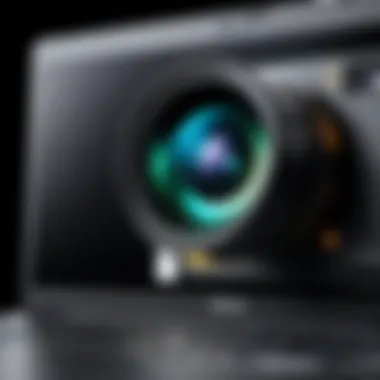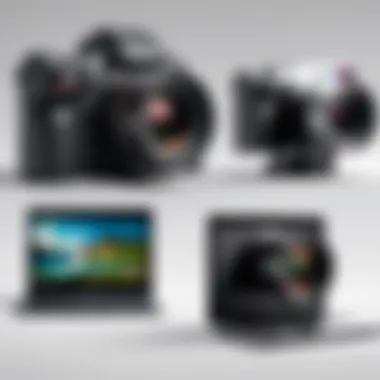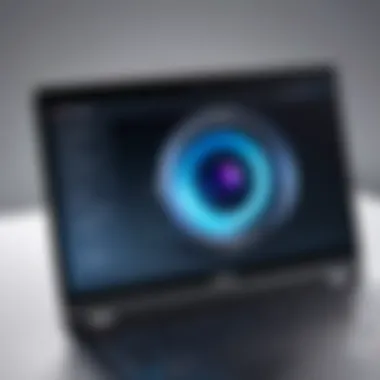Top Laptops with Exceptional Built-in Cameras


Intro
In the modern landscape of digital communication, laptops equipped with high-quality built-in cameras have become indispensable. These devices serve not only as tools for casual video calls but also play a crucial role in professional settings, where clarity and detail can make all the difference. Selecting a laptop with the best built-in camera can significantly enhance user experience, whether for remote work, content creation, or simply connecting with loved ones.
When choosing a laptop, certain attributes of the camera must be at the forefront of your considerations. Key factors include image quality, resolution, and advanced functionalities such as low-light performance and auto-focus capabilities. In this article, we will explore these parameters extensively.
As technology continues to evolve, the demand for better camera specifications has soared. Recent trends indicate that users are increasingly prioritizing sophisticated camera features, leading tech manufacturers to innovate continuously. In doing so, they address various needs, from gaming and streaming to teleconferencing and professional presentations. This guide will facilitate a deeper understanding of the current best offerings in the market, thus helping tech-savvy individuals make informed decisions.
Our journey begins with a detailed analysis of what constitutes a superior built-in camera. By zeroing in on these essential criteria, you’ll be better equipped to navigate the crowded laptop landscape.
Understanding Built-in Laptop Cameras
When delving into the world of laptops, those equipped with built-in cameras are no longer just a passing fancy. They represent a significant function in today's digitally-driven environment. As remote work, online education, and virtual socialization have become part and parcel of our lives, the quality of these cameras can profoundly influence user experience.
Built-in cameras are paramount not only for casual video calls but also for professional meetings, streaming, and even content creation. With countless laptops on the market, understanding their camera capabilities has never been more relevant. Not all built-in cameras are created equal; features such as resolution, lens quality, and light performance can vary widely.
Moreover, the integration of advanced technologies into these cameras plays a crucial role. The lens can make a world of difference when capturing clear images or high-definition videos. Whether you’re an avid gamer sharing streams or a professional attending remote meetings, the importance of top-notch camera systems cannot be overstated.
History and Evolution
The journey of built-in laptop cameras has been nothing short of remarkable. Initially, early models were limited to grainy images and vague resolutions—think low-res snapshots that barely captured the moment. Back in the early 2000s, most laptops featured 0.3 MP cameras, leaving much to be desired. But as tech enthusiasts clamored for better quality, manufacturers started upping their game.
Fast forward to present, and we witness a staggering leap. Nowadays, many laptops boast cameras with 720p or even 1080p resolution, making a substantial difference in clarity and detail. It’s not just about sharpness; enhancements in features like autofocus and frame rate have propelled the quality forward.
Purpose and Utility
Built-in laptop cameras serve diverse purposes in various fields. For the casual user, they're perfect for video calls with family or friends. Gamers enjoy the ability to engage with audiences through streaming, while creatives take advantage of seamless content creation.
On a professional front, these cameras facilitate smooth communication and collaboration, crucial in remote work settings. Consequently, businesses are investing in laptops with superior camera capabilities to ensure crystal-clear video conferencing. Furthermore, there’s an undeniable impact on branding, as companies strive to present polished images during virtual interactions.
The utility of these cameras further extends into emerging technologies, such as facial recognition and virtual reality, proving that their significance goes beyond mere video capability. With evolving trends and tools, understanding the built-in camera's purpose helps uncover the choice that will enhance both personal enjoyment and professional effectiveness.
Key Specifications to Consider
When it comes to selecting a laptop that features a top-notch built-in camera, understanding key specifications is crucial. These elements don’t just affect the camera’s performance, but they also impact the overall user experience. Whether you are joining an online meeting, streaming a game, or connecting with family, clarity and quality are paramount. Key specifications include aspects like resolution, field of view, and low light performance, all of which play significant roles in ensuring your images and videos look sharp and professional.
Resolution and Image Quality
Resolution is often the most discussed aspect when it comes to cameras, and for a good reason. Higher resolution means clearer and more detailed images. Laptops today come with various resolutions, often described in pixels—like 720p, 1080p, or even 4K. In a world where video calls have become the norm, having a camera that offers at least 720p HD resolution is essential. Imaging technology has come a long way; so many users now expect even standard models to deliver acceptable image quality.
For example, the Dell XPS series, revered for its superior camera, shows how resolution can shine through. This brilliance manifests when compared to lesser-known brands struggling with basic imaging capabilities. An enhanced resolution captures finer details, making you and your technology resonate with vitality.
One might say that image quality goes hand in hand with resolution. Consider aspects like color accuracy, sharpness, and contrast. A camera may boast high resolution but fall short in these areas. Therefore, it's essential to check reviews and performance tests, as they often unearth how the camera performs in real-world situations.
Field of View
The field of view (FoV) defines how much of the scene in front of the camera is captured. It’s akin to standing wide-eyed in a gallery—if the frame is too tight, only a tiny portion of the artwork shines through. Typically measured in degrees, a wider FoV is better for group calls or when you want more of the background visible, enhancing the overall scene.


For instance, models like the Apple MacBook Pro have a narrow FoV which might suit a single user well, yet, it makes it hard to show more than just yourself in a video chat. In contrast, laptops with a wider FoV allow for better group interaction or capturing more elements from your surroundings.
It's worth doing some research into the specifications to find the right balance for your needs, especially if you often use the camera for collaborative sessions.
Low Light Performance
Low light performance is another critical consideration that often gets overlooked. Not all environments provide ideal lighting, particularly during late-night gaming sessions or impromptu meetings in dark rooms. A camera that struggles in these conditions can lead to grainy images, making you look less than your best.
When evaluating low light performance, consider how the camera sensor responds in dim conditions. Many modern laptops utilize advanced sensor technology to compensate for lesser light, employing features like noise reduction. For reference, the HP Spectre x360 is known for its adaptability. It features a robust sensor that performs admirably in challenging lighting scenarios, allowing for crisp images even when illumination is scarce.
Top Laptops with Exceptional Built-in Cameras
In this era of constant connectivity, the need for high-quality video interactions has never been more crucial. Whether attending a crucial meeting or catching up with friends, having a laptop with a top-notch built-in camera can make a world of difference. Good cameras can produce clear, vibrant images, which enhance communication significantly. Let’s break down some leading laptops that boast impressive camera capabilities, focusing on several key aspects that make them stand out.
Dell XPS Series
Camera Features
One of the pivotal highlights of the Dell XPS Series is its camera technology. Dell has consistently prioritized user experience in its XPS line, and the camera features are no exception. With 720p or even 1080p options in various models, the clarity of video calls becomes very good. Most importantly, the placement of the camera has been improved as well. By integrating it seamlessly into the thin bezel design, users can enjoy a more engaging visual experience. The addition of a "Windows Hello" feature, which uses facial recognition for security, is another notable aspect that enhances user convenience. This makes it a solid pick for professionals who seek both functionality and style in their devices.
Real-world Performance
When it comes to real-world performance, the Dell XPS Series delivers strong results. Many users report enhanced video quality during conferences and streams, even in less-than-ideal lighting conditions. A key characteristic of the XPS cameras is their consistency; users don’t seem to experience the fluctuations in performance that are common with other brands. Some unique features like automatic light correction help ensure your image remains sharp, which is crucial for presentations or virtual meetings. However, the cameras can struggle a bit in extremely low-light environments but still outperform competitors in the same range.
Apple MacBook Pro
Quality of video streaming
The Apple MacBook Pro shines particularly in the realm of video streaming. The FaceTime HD camera offers excellent video quality, which is a significant advantage for users heavily engaged in virtual communications. Key characteristics include a high dynamic range that helps the colors pop and deliver a lifelike representation. The enhanced 1080p capability allows users to stream in detail. With a focus on smooth frame rates, the video experience feels professional and seamless, making it an attractive device for content creators and business professionals alike.
Integration with macOS
The integration of the MacBook Pro’s camera with macOS is impressive. It allows for optimizations that enhance video quality and the overall user experience. One of the highlights is the smooth functionality with applications like Zoom and FaceTime, where the camera works in harmony with various software settings. This seamless connection makes it favored by many who prioritize reliability and efficiency in tech. Nevertheless, since Apple tends to integrate hardware and software closely, there might be fewer customization options compared to other laptops.
HP Spectre x360
Design Considerations
The HP Spectre x360 is not only about powerful specs but also outstanding design. This model attracts buyers with its sleek profile and attractive aesthetics. The camera, cleverly positioned at the top of the screen, minimizes shadows on the user’s face and enhances overall image quality. Users rave about its 720p camera, which performs well for casual video calls, especially when coupled with HP’s TrueVision technology that balances color and light. However, while the design is stunning, some find the front-facing camera’s resolution slightly lower than expected from a premium device.
User Reviews
When looking at user reviews, the HP Spectre x360 garners high praise. Many owners appreciate the camera’s performance during video calls, with reports of vibrant colors and clear sound. It’s a popular choice among those who often use their devices for both work and leisure. There can be some subjective opinions about the audio quality though; while the visuals impress, not everyone feels the sound lives up to the camera's standard. Yet, on the whole, it remains favored by remote workers for its balance of aesthetics and functionality.
Lenovo ThinkPad X1 Carbon
Business Features


The Lenovo ThinkPad X1 Carbon excels particularly in business-oriented features. The built-in camera here also adopts high-definition specs, offering well-defined images ideal for serious meetings. A standout aspect is the comprehensive privacy features, which include a physical webcam cover. This feature is great for users wanting peace of mind regarding privacy without sacrificing functionality. With business users in mind, the camera adapts well to various conditions, making it a perennial favorite among professionals. However, those looking for superior aesthetics may find it less appealing compared to competitors.
Camera Innovations
In terms of camera innovations, the X1 Carbon stands on the cutting edge, particularly with its use of AI for image optimization. It assists in adjusting focus and lighting automatically, ensuring crisp visuals no matter the environment. This unique feature is particularly advantageous for those often shifting locations for calls. As much as these innovations are lauded, users occasionally mention a slower response time in adjustments under drastically changing light conditions. Still, the combination of business features and technological advancement keeps this laptop firmly in the limelight for professionals.
Comparative Analysis of Camera Quality
When it comes to laptops, the built-in camera often takes a backseat to more flashy features like graphics cards or processing power. However, neglecting the camera's quality can lead to a subpar experience, especially in an era where video conferencing, streaming, and virtual communication play pivotal roles. A comparative analysis of camera quality is not merely an academic exercise; it’s a practical approach to understanding how different factors influence performance. This section casts a spotlight on the crucial specifications, user experiences, and industry benchmarks that can guide tech enthusiasts in their quest for a laptop with an exceptional camera.
Benchmark Testing
Benchmark testing is the linchpin of understanding camera quality in laptops. Much like how automobile enthusiasts evaluate engines, we scrutinize cameras based on specific metrics. The primary aspects include resolution, frame rate, color accuracy, and low-light performance. Each of these elements paints a clearer picture of what consumers can expect in real-world usage.
To conduct benchmark tests, various software tools are employed. These applications assess how effectively a camera performs under standardized conditions. For instance, tools might measure how a camera handles different lighting scenarios—bright sunlight versus dimly lit rooms. The reasoning behind this is straightforward. Many users often find themselves video chatting or streaming from locations that aren't perfectly illuminated. Tests can reveal significant differences among brands like [Dell], [Apple], and [HP], showing variances that casual users might overlook.
Key components tested in benchmarks:
- Resolution: A higher megapixel count often translates to clearer images, but this is not the whole story.
- Low-light capabilities: Critical for webinars or gaming sessions held in less-than-ideal lighting.
- Color fidelity: The extent to which colors appear true to life, which can influence video presentation.
- Frame rate consistency: Important for smooth video playback, especially in dynamic situations like gaming.
User Experience Feedback
User experience feedback is another invaluable component of the comparative analysis. While benchmark testing gives a technical overview, the real-world applications are often where the rubber meets the road. The way users react to their laptop’s camera during meetings or stream sessions can provide deeper insights into its practical utility.
Surveys and reviews on sites like [reddit.com] highlight what users love and what they loathe about their built-in cameras. Common complaints may include grainy images in low light or issues with auto-focus that lag when users try to reframe themselves. On the flip side, positive feedback often praises consistent HD clarity and color richness during video calls.
Considerations through user feedback include:
- Ease of use: How straightforward it is to set up and utilize the camera for various applications.
- Reliability: Users discuss whether the camera performs reliably over long sessions of usage without overheating or lagging.
- Integration with software: How well the camera works with popular conferencing tools like Zoom, Microsoft Teams, and gaming applications.
User experiences provide nuanced perspectives that data alone cannot capture, bridging gaps between specifications and everyday usability.
Advanced Camera Technologies in Laptops
When it comes to modern laptops, the built-in camera is not just a mere afterthought; it's an essential component that often influences users' overall experience. Laptops equipped with advanced camera technologies enhance virtual communication, boost professional presentations, and elevate entertainment. As we dive deeper, it’s clear that features like artificial intelligence (AI) integration and privacy measures are transforming the landscape of laptop cameras.
AI Integration
Artificial intelligence is weaving itself into the fabric of laptop camera technology. Its role cannot be overstated; AI has the potential to improve image quality significantly, manipulating various elements to create sharper, clearer visuals. Here are some key benefits of AI integration:
- Smart Image Processing: AI can automatically adjust lighting and enhance colors, especially in challenging conditions. For instance, users facing backlighting can experience improved image quality without the need for manual adjustments.
- Facial Recognition: This goes beyond just aesthetics—AI can detect faces and focus on subjects, making video calls feel more professional. Laptops like the Dell XPS series utilize this technology to engage users smoothly during a conference or a casual chat.
- Real-Time Background Blur: AI also enables real-time effects, such as blurring the background during video calls. This feature is crucial for maintaining professionalism, especially in business settings.
In short, laptops with AI-enhanced cameras bring a level of sophistication that basic models simply can't match. It's about making life easier and enhancing the visual experience.
Privacy Features and Security
With the rise in remote work and virtual interactions, privacy and security features of laptop cameras have become paramount. Users are rightly concerned about how easily they can be accessed and whether their privacy is being compromised. Let’s look at some effective strategies that innovative laptop brands have taken:


- Physical Shutters: A straightforward yet effective solution is the addition of physical camera shutters. This enables users to physically cover the camera when not in use, offering peace of mind.
- Privacy Indicators: Some laptops are now equipped with LED indicators that illuminate when the camera is active, alerting users to potential monitoring.
- Enhanced Security Protocols: On the software side, brands like Apple and HP offer robust security measures, ensuring that their systems protect users against unauthorized access. Features such as strong encryption and software that restricts camera access are quite helpful.
The safety of personal information has grown paramount; the integration of such features ensures users feel secure while enjoying tech-savvy solutions.
These privacy measures are not just about protection but about fostering trust in technology. As the use of built-in cameras rises, the demand for secure and private options continues to grow.
Future Trends in Laptop Camera Technology
The trajectory of laptop camera technology stands on the brink of significant advancements. While in the past, built-in cameras were often sidelined as mere add-ons, today they’re pivotal to creating immersive experiences, especially for those reeling into video communication and content creation. As the demand for high-quality visual engagement grows — whether it's for remote work, gaming, or streaming — so does the need for innovative camera solutions.
Embracing these shifts becomes essential for users, as next-gen laptop cameras promise enhanced usability, image quality, and features that reflect the priorities of modern consumers. Here, we delve into emerging trends and potential directions this technology might take.
Emerging Innovations
As we look ahead, innovations in camera technology are like the sun peeking through the clouds, signaling a refreshing change. There’s a palpable shift towards integrating higher resolutions and specialized features that cater specifically to the needs of gamers and streamers.
- 4K Resolution: Much like how a clear day enhances our view, 4K resolution in laptop cameras can provide a stunning visual clarity. This is particularly valuable for content creators who rely on crisp, detailed visuals during streams or recordings.
- AI-powered Capabilities: Artificial intelligence has already started making waves, and it’s primed to transform how cameras function. Features like background blurring are becoming more sophisticated, allowing for professional-looking results right off the bat. There’s also the prospect of auto-enhancement, where the camera optimizes settings based on lighting and subject distance dynamically.
- Privacy Features: With rising concerns around privacy, future cameras may include hardware-based privacy controls, such as physical shutters or more reliable facial recognition technology that can only be accessed with specific user consent.
Adding these features creates an ecosystem that responds directly to the needs and desires of today’s tech-savvy populace. As such innovations unfold, they are set to redefine how we communicate and connect through technology.
Predictions for Upcoming Models
It’s all well and good to ponder on what’s currently available, but the real fun lies in speculating what’s around the corner. Expect to see some exciting developments shortly, prompted by the need for better integration of camera technologies in laptops.
- Increased Frame Rates: Higher frame rates for smoother video will likely become standard offerings. This enhancement is particularly appealing for gamers who need fluid, uninterrupted motion during gameplay.
- Integration with Augmented Reality (AR): Picture this: laptops equipped with cameras that can seamlessly interact with AR environments. This could revolutionize how we play games or engage with applications, offering experiences that blend the physical and digital worlds.
- Smart Tracking Technology: Much like how a hawk spots its prey, future laptops may possess intelligent zoom features that can track subjects during video calls or streams. This technology would improve interactive capabilities, ensuring that users remain in focus no matter their movements.
Emerging trends in laptop camera technology indeed hold promise. By staying ahead of the curves, tech enthusiasts and gamers can arm themselves with the knowledge they need to make informed decisions about their next devices.
Laptop cameras have evolved from simple tools into essential components of digital interaction and expression, shaping how we connect in an increasingly virtual world.
Ending and Recommendations
In wrapping up our exploration of laptops flaunting superior built-in cameras, it’s vital to reflect on how the right choice can reshape your digital experience. This section serves to consolidate our findings and provide you with actionable takeaways that align with your specific needs.
Choosing a laptop with an exceptional camera isn’t just about pixel counts or snazzy specs; it’s about how those elements resonate with your daily usage. Whether you are a professional engrossed in video conferencing, a content creator eager to stream in high quality, or a gamer wanting to showcase your skills, the right laptop can make all the difference. Emphasizing the significance of image quality, low-light performance, and versatility allows you to navigate through various options while avoiding pitfalls.
Aspects such as connectivity with other devices, ease of use, and overall portability are equally important. After all, a camera’s performance isn’t solely evaluated in isolation but rather in how it enhances the entire laptop experience.
"The best choice blends high performance with your unique usage priorities."
Best Choices for Different Users
- For Professionals: If your main focus is reliability for video calls and collaborative meetings, models like the Dell XPS Series are outstanding. Not only do they provide superb image quality, but they also come with advanced noise-cancellation technology that ensures clarity.
- For Creators: The Apple MacBook Pro stands tall, offering seamless integration with editing software and exceptional streaming capabilities. It excels in image and video fidelity, which is crucial for creatives who cannot compromise on visual quality.
- For Gamers: The HP Spectre x360 combines an excellent camera with a stunning display, perfect for streaming on platforms like Twitch. Its versatility makes it equally adept at handling both gaming and professional tasks without breaking a sweat.
- For Business Users: The Lenovo ThinkPad X1 Carbon offers robust security features and stellar performance in various lighting conditions. It’s tailored for those who demand professionalism wrapped in high-quality video performance.
In summation, evaluating your personal or professional needs alongside the camera specifications will arm you with the knowledge to select the laptop that fits like a glove.
Final Thoughts on Selecting the Ideal Laptop
As the digital landscape continues to evolve, so do the standards for built-in laptop cameras. The ideal laptop is more than just high resolution; it’s about the synergy between hardware and user needs. One must consider not only the current state of technology but also how it can adapt to future demands.
An informed decision requires sifting through various options, weighing features against potential use cases, not just for today but for tomorrow. By keeping up-to-date with trends in camera technology, you equip yourself with foresight—an invaluable asset in a fast-paced tech-driven world.
To encapsulate, when seeking out the perfect laptop with the best built-in camera, consider this an investment in your productivity, creativity, and connectivity. Remember, great technology does not just serve a purpose; it enhances the way we communicate, create, and collaborate.
Embarking on this journey with a clear set of priorities will not only lead you to better technology but also ensure it enriches your daily life.



